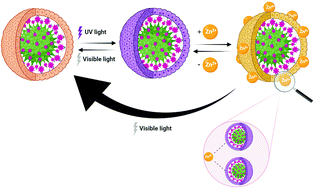Fabrication of a light-responsive polymer nanocomposite containing spiropyran as a sensor for reversible recognition of metal ions†
Abstract
Recognition of metal ions using different methods such as HPLC, ICP-MS, ICP-AES, etc. has many limitations including expensiveness, time-consuming process, and the need for advanced equipment. These limitations were extensively solved by the fabrication of poly(spiropyran ethylacrylate-co-glycidyl methacrylate) (P(SPEA-co-GMA)) as a novel stimuli-responsive polymer. Surface-initiated ATRP was employed for grafting of the P(SPEA-co-GMA) copolymer onto the surface of modified TiO2. The synthesized compounds were identified by FT-IR, NMR, TGA, GPC, BET, and UV-Vis analyses. The decrease of the surface area from 37.2 m2 g−1 for TiO2 nanoparticles to 33.5 m2 g−1 for TiO2-g-P(SPEA-co-GMA) confirmed the successful grafting of P(SPEA-co-GMA) onto the surface. A grafting density of 0.135 chains per nm2 was calculated for the attached polymer. For better control over the polymerization, the TiO2-g-P(SPEA-co-GMA) nanocomposite was synthesized in the presence of a sacrificial initiator. The results of the GPC analysis showed a relatively good polydispersity index (∼1.8). According to the TGA, UV-Vis, and AFM analyses, TiO2-g-P(SPEA-co-GMA) showed increased thermal stability, improved optical properties, and the appropriate dispersion in THF, respectively. The photochromic moiety (SP) of the synthesized copolymer was transformed into the merocyanine (MC) isomer in the presence of UV light, allowing it to selectively complex with the Zn2+ cation from the phenolate anion moiety in the solid state. The photochromic nanocomposites showed good fatigue resistance against Zn2+. Finally, the fabricated optical/chemical-responsive polymer can be a good alternative sensor due to its portability, high detection speed, and relatively low price.



 Please wait while we load your content...
Please wait while we load your content...